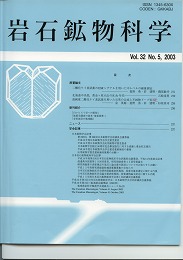Volume 43, Issue 6
November
Displaying 1-8 of 8 articles from this issue
- |<
- <
- 1
- >
- >|
Message from the President
-
2014 Volume 43 Issue 6 Pages 201-202
Published: 2014
Released on J-STAGE: December 29, 2014
Download PDF (238K)
Original Article
-
2014 Volume 43 Issue 6 Pages 203-214
Published: 2014
Released on J-STAGE: December 29, 2014
Advance online publication: December 06, 2014Download PDF (5436K)
Special Issue “Japanese granites and tectonics” Part 3
Original Article
-
2014 Volume 43 Issue 6 Pages 215-217
Published: 2014
Released on J-STAGE: December 29, 2014
Download PDF (2337K)
Book Review
-
2014 Volume 43 Issue 6 Pages 228a
Published: 2014
Released on J-STAGE: December 29, 2014
Download PDF (166K)
News
-
2014 Volume 43 Issue 6 Pages 228b
Published: 2014
Released on J-STAGE: December 29, 2014
Download PDF (181K)
Announcements from the Association
-
2014 Volume 43 Issue 6 Pages 229-246
Published: 2014
Released on J-STAGE: December 29, 2014
Download PDF (1428K)
-
2014 Volume 43 Issue 6 Pages 247-248
Published: 2014
Released on J-STAGE: December 29, 2014
Download PDF (2241K)
Contents
-
2014 Volume 43 Issue 6 Pages 43C1-43C2
Published: 2014
Released on J-STAGE: December 29, 2014
Download PDF (190K)
- |<
- <
- 1
- >
- >|
